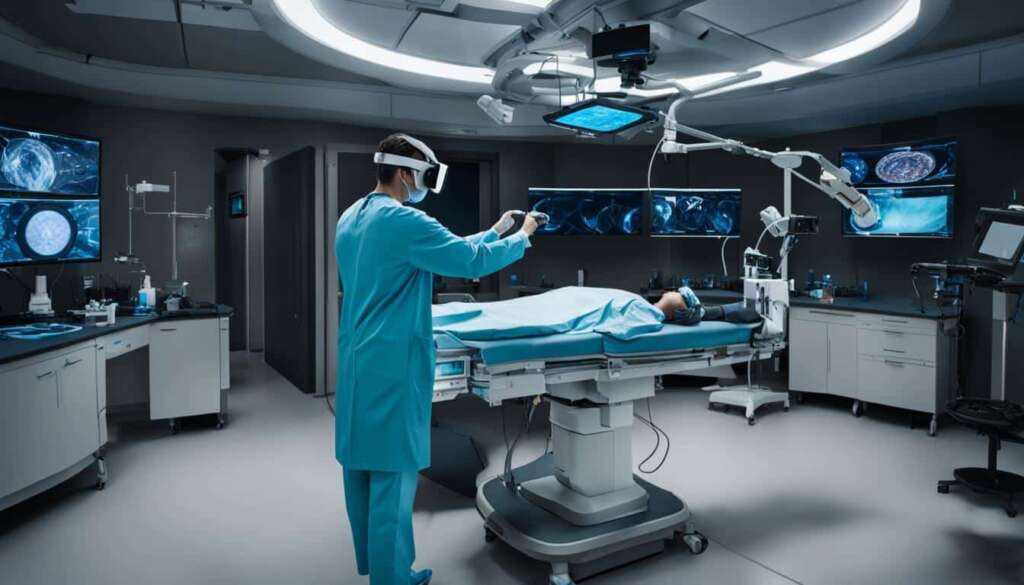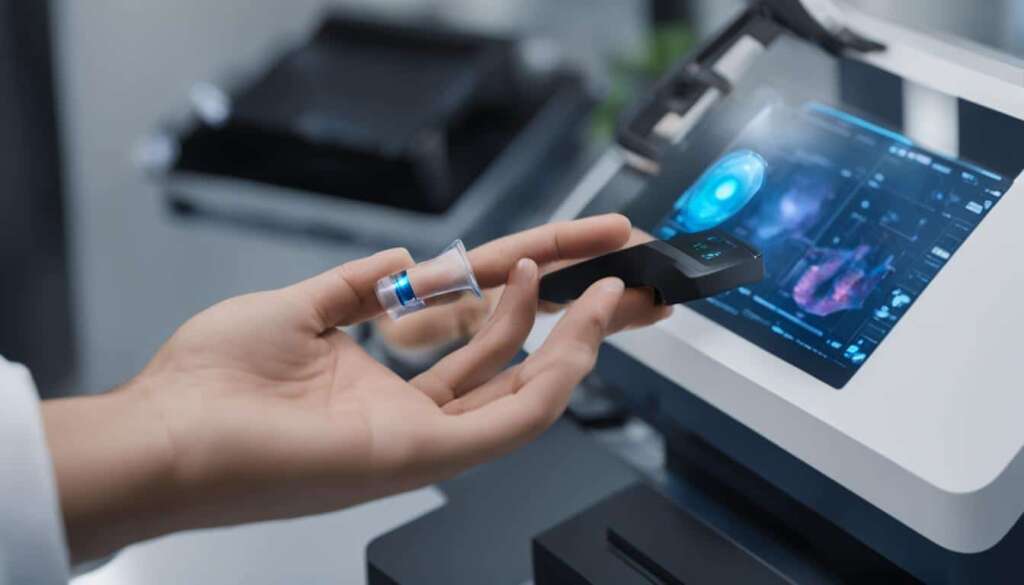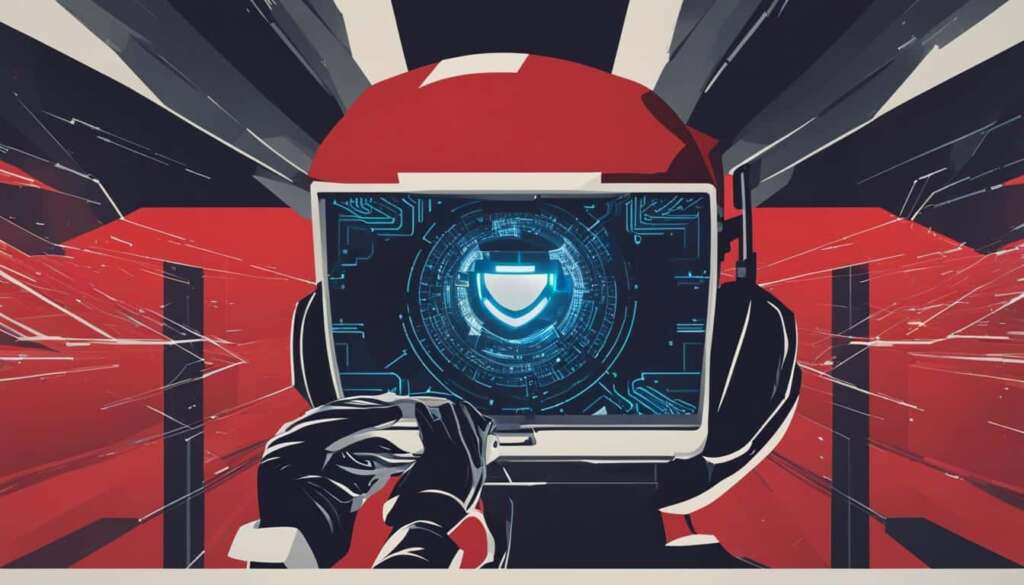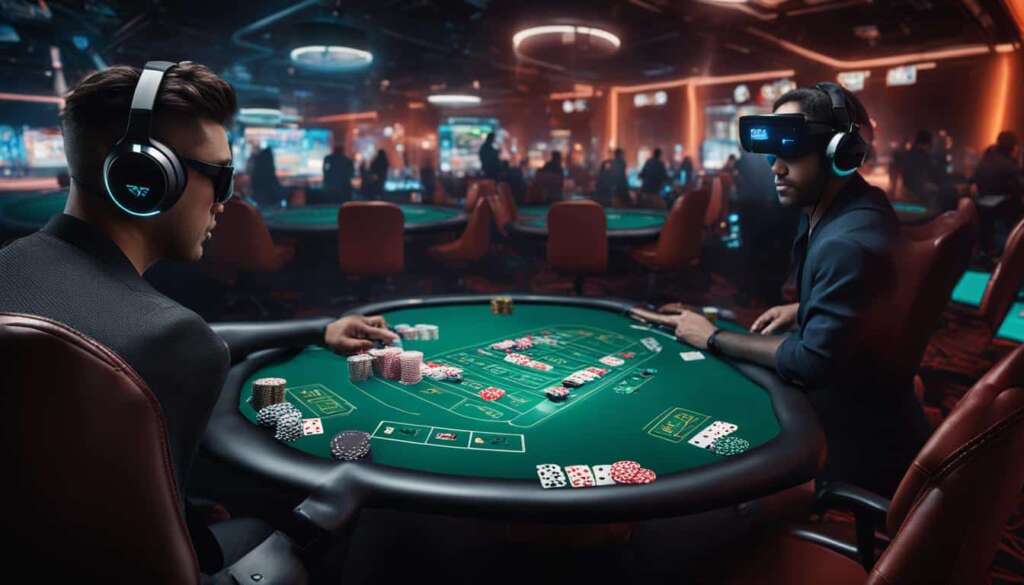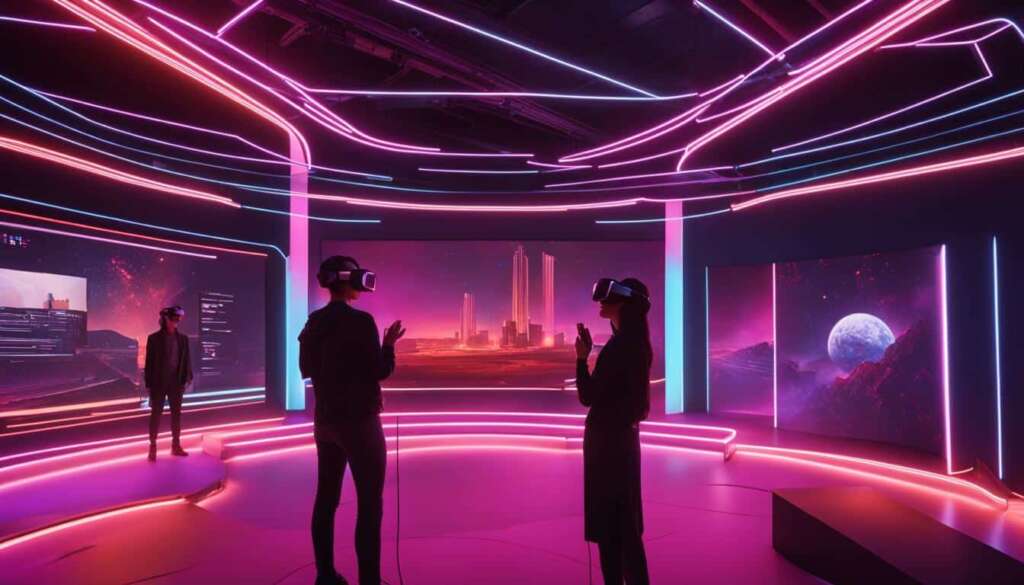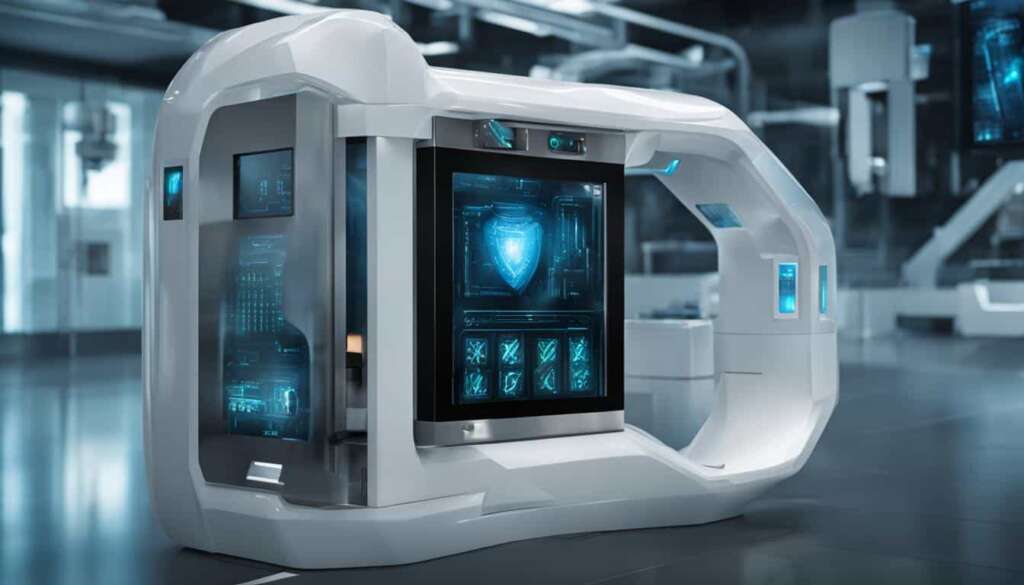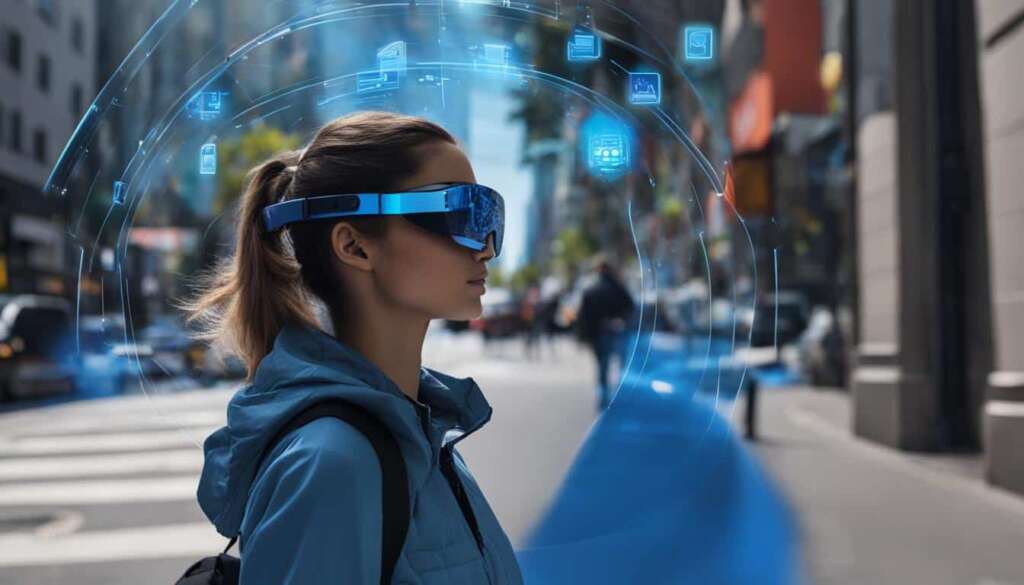Table of Contents
Augmented reality (AR) and virtual reality (VR) technologies are transforming the healthcare industry, particularly in the field of medical training. These immersive technologies provide new opportunities for surgical procedures, medical education, and skills development.
The integration of AR and VR in the operating room improves accuracy, reduces errors, and minimises invasiveness. In medical education, AR and VR create realistic and interactive learning experiences, allowing trainee surgeons to practice procedures and understand anatomical structures.
With AR, surgeons can overlay virtual 3D images onto the human body, providing a clearer view of underlying structures and improving precision during surgery. VR, on the other hand, offers trainee surgeons realistic simulations of complex procedures, allowing them to practice and refine their skills in a risk-free environment.
AR and VR technologies are revolutionising medical education and skills development. These technologies offer rich learning opportunities for medical professionals, allowing them to integrate theory with practice and make real-time clinical decisions.
AR and VR are transforming surgery training by providing immersive environments for simulation and game-based learning. VR training for procedures has been found to be faster and more accurate than traditional training methods.
AR and VR technologies are also being used to assess facility designs and improve patient safety. By creating digital facility mockups and using ML-based analytics, architects can evaluate the effect of architectural designs on patient safety and reduce healthcare-related costs.
Furthermore, AR and VR technologies enable healthcare professionals to empathise with patients and improve the patient experience. Immersive VR allows doctors to experience specific conditions and symptoms, helping them understand patients on a deeper level.
AR and VR have shown promise in relieving pain and reducing acute and chronic pain in medical procedures. VR can significantly reduce the perception of pain by engaging the senses and diverting the brain’s attention.
AR and VR solutions are making healthcare training more engaging and effective. VR allows for the creation of immersive learning experiences at a low cost, offering opportunities for personalized and interactive training.
In conclusion, AR and VR technologies are revolutionising the healthcare industry, particularly in the field of medical training. These immersive technologies have the potential to enhance surgical procedures, improve medical education, and develop critical skills.
The Potential of AR and VR in the Operating Room
AR and VR technologies have immense potential to revolutionize surgical procedures in the operating room. Augmented reality (AR) allows surgeons to overlay virtual 3D images onto the human body, providing a clearer view of underlying structures and improving precision during surgery. This immersive environment enhances the surgeon’s ability to navigate complex anatomical structures with greater accuracy and reduced invasiveness.
Virtual reality (VR) offers trainee surgeons realistic simulations of complex procedures, allowing them to practice and refine their skills in a risk-free environment. With VR, surgeons can experience the intricacies of surgical techniques, learn to handle unexpected complications, and develop their decision-making abilities. By providing an immersive learning experience, VR enables trainees to gain confidence and competence in surgical procedures before performing them on actual patients.
In recent years, major technological companies have invested in AR and VR tools specifically designed for the operating room. EchoPixel’s True 3D, for example, enables surgeons to visualize patient-specific anatomy through holographic displays, enhancing preoperative planning and intraoperative guidance. Google Glass and Microsoft’s HoloLens allow surgeons to access real-time information, such as patient vital signs or imaging results, without distracting from the surgical field. These advancements in AR and VR technology are transforming surgical practices and paving the way for safer, more efficient procedures.
| AR in the Operating Room | VR in the Operating Room |
|---|---|
| Overlay virtual 3D images onto the human body | Realistic simulations of complex procedures |
| Improve precision and accuracy during surgery | Practice and refine surgical skills in a risk-free environment |
| Enhance navigation through complex anatomical structures | Gain confidence and competence in surgical techniques |
| Enable preoperative planning and intraoperative guidance | Experience the intricacies of surgical procedures |
Technology Advancements in AR and VR for the Operating Room
Technology advancements in AR and VR for the operating room continue to push the boundaries of surgical innovation. These advancements enable surgeons to perform procedures with greater precision and proficiency, while also improving patient outcomes. As AR and VR become more integrated into surgical practices, the possibilities for enhancing surgical techniques, education, and patient care are boundless.
Enhancing Medical Education with AR and VR
Augmented Reality (AR) and Virtual Reality (VR) technologies are revolutionizing medical education and skills development. These immersive technologies offer a range of innovative learning opportunities for medical professionals, allowing them to integrate theoretical knowledge with practical application and make real-time clinical decisions.
VR simulation platforms, such as Surgical Theater and Osso VR, provide trainee surgeons with a controlled setting to practice various procedures and develop their competencies. These simulations offer a realistic and interactive learning environment, where trainees can gain valuable hands-on experience without the risk associated with real-life surgeries. The use of VR in medical education enables trainees to refine their surgical techniques, improve their decision-making skills, and develop the confidence necessary for successful patient outcomes.
In addition to VR, AR technologies are also enhancing medical education by overlaying three-dimensional imagery onto medical mannequins or cadavers. This allows students to have a better understanding of anatomical structures and visualize complex medical concepts in a more immersive and interactive way. By incorporating AR and VR into medical education, institutions can create more engaging and effective learning experiences while reducing costs associated with traditional teaching methods.
With the integration of AR and VR, medical professionals can further enhance their knowledge, skills, and competencies in a safe and controlled environment. These technologies have the potential to revolutionize medical education by providing realistic simulations, interactive learning experiences, and personalized training opportunities. As the adoption of AR and VR continues to grow, medical professionals will be better equipped to deliver high-quality care, improving patient outcomes and revolutionizing the healthcare industry.
The Benefits of AR and VR in Medical Education:
- Immersive and interactive learning experiences
- Realistic simulations for skills development
- Enhanced understanding of anatomical structures
- Improved decision-making and critical thinking skills
- Cost-effective alternative to traditional teaching methods
- Reduced risks associated with real-life surgeries
AR and VR in Surgery Training
AR and VR technologies are revolutionizing surgery training by providing an immersive environment for simulation and game-based learning. These technologies offer a unique opportunity for surgeons to enhance their skills and knowledge in a safe and controlled setting.
Virtual Reality (VR) allows trainee surgeons to practice complex procedures without the risk associated with real patients. Using VR headsets, surgeons can engage in realistic simulations that mimic the challenges and intricacies of surgical procedures. This enables them to develop their dexterity, decision-making abilities, and overall surgical proficiency.
| Benefits of VR in Surgery Training | Examples of VR Solutions |
|---|---|
| Enhanced skill development | SimInsights’ VR surgical environment |
| Improved decision-making under pressure | Surgical Theater’s virtual surgical planning |
| Safe and risk-free learning environment | Osso VR’s surgical simulation platform |
Augmented Reality (AR) is another technology transforming surgery training. With AR, surgeons can overlay digital information onto the real world, providing real-time guidance and support during procedures. Surgeons can use AR for tele-mentoring, where experts can remotely guide and provide tailored instructions, enhancing the learning experience and fostering collaboration.
AR and VR technologies in surgery training are paving the way for more immersive, engaging, and effective learning experiences for surgeons. They have the potential to accelerate skill development, improve decision-making, and ultimately enhance patient outcomes.
Game-based Learning in Surgery
Game-based learning is an emerging trend in surgery training, leveraging the power of AR and VR to create interactive and engaging educational experiences. By gamifying surgical scenarios, trainee surgeons can enhance their problem-solving skills, critical thinking abilities, and teamwork.
- Virtual reality games can simulate different surgical scenarios, challenging surgeons to make quick and accurate decisions in a realistic operating room environment.
- AR games can overlay virtual objects on top of real-world surgical equipment, providing trainees with interactive guidance and feedback during procedures.
- Game-based learning not only enhances technical skills but also encourages collaboration and effective communication among surgical teams.
Overall, the integration of AR and VR technologies in surgery training is revolutionizing the way surgeons learn and develop their skills. These immersive environments, combined with game-based learning approaches, offer a powerful and impactful method for surgical education and continuous professional development.
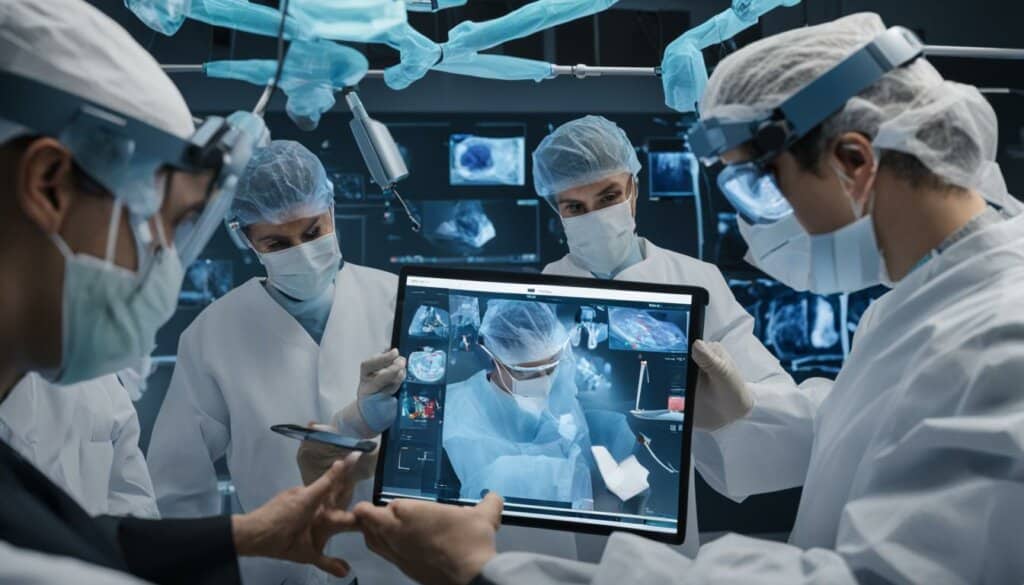
AR and VR in Facility Design and Patient Safety
AR and VR technologies have emerged as powerful tools in the realm of facility design and patient safety within the healthcare industry. These immersive technologies offer unique advantages, allowing architects and healthcare professionals to optimize the design of healthcare facilities and enhance patient safety.
By utilizing AR and VR, architects can create digital mockups of healthcare facilities, providing a realistic visualization of the space and allowing for the identification of potential safety hazards. This enables architects to make informed decisions and mitigate risks before the construction phase, saving both time and resources. Additionally, ML-based analytics can be employed to evaluate the impact of architectural designs on patient safety, further enhancing the overall effectiveness of facility design.
Furthermore, the integration of AR and VR in facility design eliminates the need for physical mockups, reducing costs and increasing convenience. Virtual simulations provide in-simulation video and performance data, enabling architects and healthcare professionals to make informed decisions and automate the design process. The ability to analyze and optimize architectural designs with AR and VR technologies has the potential to revolutionize healthcare facilities and improve patient safety.
Benefits of AR and VR in Facility Design and Patient Safety
- Enhanced visualization of facility designs
- Identification of potential safety hazards
- Cost reduction through elimination of physical mockups
- Convenience through in-simulation video and performance data
- Automated decision-making with machine learning-based analytics
By leveraging AR and VR technologies in facility design and patient safety, healthcare professionals can optimize the design of healthcare facilities, ensuring the highest level of patient safety. The integration of these immersive technologies has the potential to transform healthcare facilities and create environments that prioritize patient well-being and optimal care delivery.
| Benefits of AR and VR in Facility Design and Patient Safety |
|---|
| Enhanced visualization of facility designs |
| Identification of potential safety hazards |
| Cost reduction through elimination of physical mockups |
| Convenience through in-simulation video and performance data |
| Automated decision-making with machine learning-based analytics |
The seamless integration of AR and VR into facility design has the potential to create healthcare environments that prioritize patient safety and optimize the delivery of care. By harnessing the power of these immersive technologies, architects and healthcare professionals can work together to ensure that healthcare facilities are designed and structured in a way that maximizes patient well-being and safety.
Empathy Building in Healthcare with AR and VR
AR and VR technologies have opened up new possibilities for empathy building in the healthcare industry. By immersing healthcare professionals in realistic and interactive virtual environments, AR and VR allow doctors to gain a deeper understanding of their patients’ experiences and improve the overall patient experience.
One of the ways AR and VR foster empathy is by enabling doctors to embody patients with specific conditions and symptoms. Through immersive VR simulations, doctors can step into the shoes of patients with dementia, for example. By experiencing firsthand the challenges and frustrations faced by these patients, doctors can gain valuable insights into their needs and provide more compassionate care.
Additionally, VR technology allows doctors to practice delivering difficult news, such as a terminal illness diagnosis, in a safe and controlled environment. By rehearsing these conversations in VR, doctors can refine their communication skills and develop strategies for delivering sensitive information with empathy and compassion.
AR and VR technologies enable healthcare professionals to empathize with patients and improve the patient experience. Immersive VR allows doctors to experience specific conditions and symptoms, helping them understand patients on a deeper level.
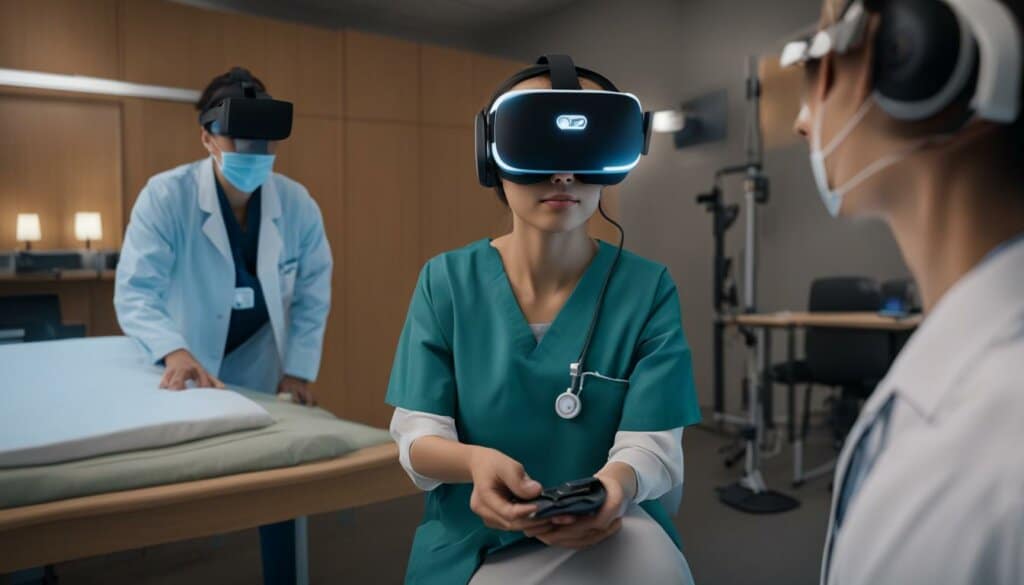
By leveraging AR and VR technologies, healthcare professionals can enhance their ability to connect with patients on a human level. This heightened empathy can lead to improved patient satisfaction, better patient-doctor relationships, and ultimately, more effective healthcare outcomes.
| Benefits of Empathy Building with AR and VR | Applications in Healthcare |
|---|---|
| Improved patient satisfaction | Patient care and communication |
| Enhanced patient-doctor relationships | Terminal illness communication |
| Better understanding of patient needs | Empathy training |
Overall, AR and VR technologies offer healthcare professionals powerful tools for developing a deeper understanding of their patients’ experiences. Through empathy building, these technologies have the potential to revolutionize the way healthcare is delivered, fostering more compassionate and patient-centered care.
Pain Management with AR and VR
AR and VR technologies are revolutionizing pain management in the healthcare industry. By immersing patients in virtual reality environments, these technologies offer non-pharmacological analgesia methods that can significantly reduce the perception of pain during medical procedures. Through the power of immersive VR, patients can be engaged in challenging and interactive games that divert their attention and effectively reboot the brain’s pain networks.
Virtual reality has shown promise in reducing pain during various medical procedures, including wound care, chemotherapy, dental procedures, and routine medical interventions. By providing a distraction and engaging the senses, VR can help patients experience less pain and discomfort during these procedures, enhancing their overall healthcare experience.
“VR pain management has the potential to transform the way we approach pain relief in healthcare. By engaging patients in immersive virtual environments, we can effectively reduce their perception of pain and improve their quality of life,” says Dr. Emily Turner, a leading expert in VR pain management.
Benefits of AR and VR in Pain Management
AR and VR offer several benefits in pain management, including:
- Non-pharmacological analgesia: AR and VR provide alternative pain management methods that reduce the reliance on traditional pharmacological approaches, minimizing potential side effects.
- Reduced perception of pain: Immersive VR environments divert the brain’s attention, effectively reducing the perception of pain.
- Enhanced patient experience: By creating engaging and interactive experiences, AR and VR improve the overall patient experience during medical procedures.
The use of AR and VR in pain management demonstrates the transformative potential of immersive technologies in healthcare. By combining technological advancements with patient-centric care, healthcare providers can improve pain relief strategies and enhance patient outcomes.
| Procedure | Pain Reduction with VR (%) |
|---|---|
| Wound care | 60% |
| Chemotherapy | 50% |
| Dental procedures | 40% |
| Routine medical interventions | 30% |
Table: Percentage of pain reduction with VR in different medical procedures. Source: Research studies.
AR and VR in Healthcare Training
AR and VR solutions are revolutionizing healthcare training, offering a more engaging and effective learning experience for healthcare professionals. These immersive technologies are transforming traditional training methods, providing opportunities for personalized and interactive education.
Enhancing Engagement with Escape Rooms
A particularly exciting development in healthcare training is the adaptation of escape rooms into the virtual realm. By translating the concept of escape rooms into VR experiences, trainees can navigate complex scenarios, solve puzzles, and apply their medical knowledge in a realistic and immersive environment. This innovative approach to learning not only enhances engagement but also enables trainees to develop critical thinking skills and apply theoretical knowledge to practical situations.
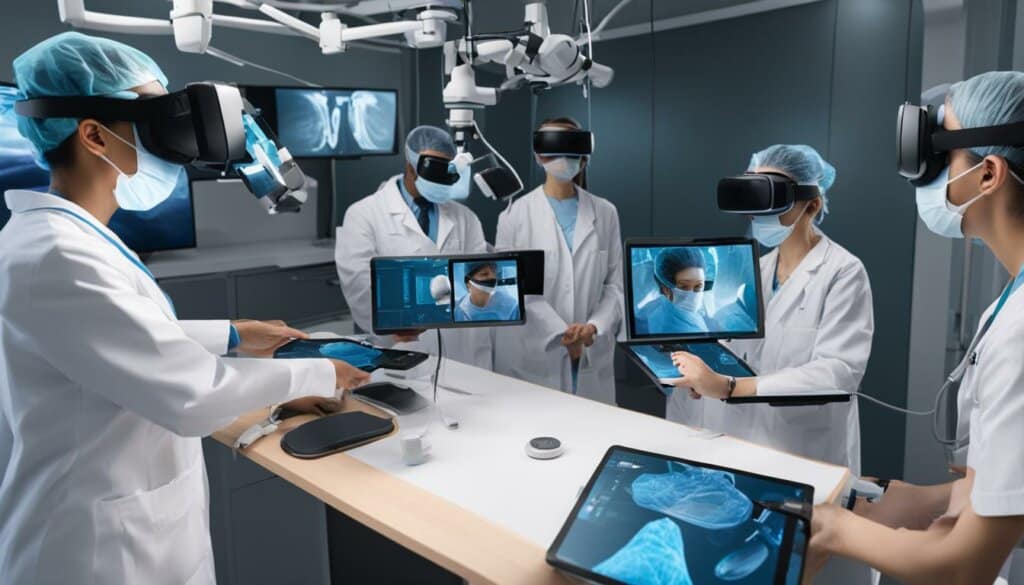
The use of escape rooms in healthcare training leverages the inherent motivation and excitement of the game-like environment to create an effective learning experience. Trainees are actively involved in problem-solving, decision-making, and teamwork, simulating real-life situations they may encounter in their medical practice. By allowing trainees to learn through hands-on experience in a risk-free environment, AR and VR escape rooms offer the potential for accelerated learning and skill development.
Promoting Immersive and Interactive Learning
AR and VR technologies also enable healthcare professionals to engage with realistic simulations, interactive scenarios, and virtual patient encounters. These immersive learning experiences provide a safe space for trainees to practice their skills, make clinical decisions, and develop their confidence in medical procedures. By interacting with virtual patients, trainees can refine their communication skills, empathy, and bedside manner, ultimately enhancing the overall patient experience.
Furthermore, AR and VR in healthcare training facilitate collaboration and knowledge sharing among healthcare professionals. Trainees can engage in virtual interprofessional simulations, working alongside colleagues from different disciplines to solve complex medical cases. This collaborative learning approach fosters teamwork and the development of interdisciplinary skills, preparing healthcare professionals for the multidisciplinary nature of modern healthcare practice.
| Benefits of AR and VR in Healthcare Training | Examples |
|---|---|
| Enhanced engagement and motivation | AR and VR escape rooms |
| Realistic simulations and virtual patient encounters | Medical procedure simulations, virtual patient interactions |
| Safe space for practice and skill development | Virtual surgical simulations, procedural training |
| Collaborative learning opportunities | Interprofessional simulations, teamwork exercises |
AR and VR are reshaping the landscape of healthcare training, providing a dynamic and effective learning environment. As these technologies continue to advance, the future of healthcare education holds promising possibilities for improved skills development, enhanced patient care, and the revolutionization of medical training.
Conclusion
AR and VR technologies are revolutionizing the healthcare industry, particularly in the field of medical training. These immersive technologies have the potential to enhance surgical procedures, improve medical education, and develop critical skills.
From the operating room to medical education institutions, AR and VR are transforming the way healthcare professionals learn and deliver care. The integration of AR and VR creates a brighter future for the healthcare industry, with more effective, efficient, and safer practices that benefit patients, doctors, nurses, and other healthcare staff.
By embracing AR and VR, the healthcare industry can revolutionize medical training and stay at the forefront of innovation. These technologies offer unprecedented opportunities for continuous learning, skill development, and improved patient outcomes. As the adoption of AR and VR continues to grow, the healthcare industry stands to benefit from a more advanced and capable workforce, ultimately leading to a higher standard of care for patients.
FAQ
How are AR and VR revolutionizing medical training?
AR and VR technologies are transforming the healthcare industry, particularly in the field of medical training. These immersive technologies provide new opportunities for surgical procedures, medical education, and skills development.
What is the potential of AR and VR in the operating room?
AR and VR technologies have the potential to revolutionize surgical procedures in the operating room. With AR, surgeons can overlay virtual 3D images onto the human body, providing a clearer view of underlying structures and improving precision during surgery. VR, on the other hand, offers trainee surgeons realistic simulations of complex procedures, allowing them to practice and refine their skills in a risk-free environment.
How can AR and VR enhance medical education?
AR and VR technologies offer rich learning opportunities for medical professionals, allowing them to integrate theory with practice and make real-time clinical decisions. VR simulation platforms provide trainee surgeons with a controlled setting to practice various procedures and develop competencies. AR technologies overlay three-dimensional imagery onto medical mannequins or cadavers, enhancing understanding of anatomical structures.
In what ways are AR and VR transforming surgery training?
AR and VR technologies are transforming surgery training by providing immersive environments for simulation and game-based learning. VR training for procedures has been found to be faster and more accurate than traditional training methods. Surgeons can use AR for tele-mentoring, where experts can see what the surgeon is seeing and provide tailored guidance in real-time.
How are AR and VR used in facility design and patient safety?
AR and VR technologies are being used to assess facility designs and improve patient safety. By creating digital facility mockups and using ML-based analytics, architects can evaluate the effect of architectural designs on patient safety and reduce healthcare-related costs. AR and VR provide cost reduction by eliminating physical mockups and convenience through the availability of in-simulation video and performance data.
How do AR and VR enable empathy building in healthcare?
AR and VR technologies enable healthcare professionals to empathize with patients and improve the patient experience. Immersive VR allows doctors to experience specific conditions and symptoms, helping them understand patients on a deeper level. VR also allows doctors to practice delivering news about terminal illnesses or end-of-life steps, enabling them to tailor their communication to be more considerate.
How can AR and VR be used for pain management?
AR and VR have shown promise in relieving pain and reducing acute and chronic pain in medical procedures. By engaging the senses and diverting the brain’s attention, VR can significantly reduce the perception of pain. VR can be particularly useful in reducing pain during wound care, chemotherapy, dental procedures, and routine medical procedures.
How are AR and VR changing healthcare training?
AR and VR solutions are making healthcare training more engaging and effective. VR allows for the creation of immersive learning experiences at a low cost, offering opportunities for personalized and interactive training. The ability to share information in new and engaging ways mitigates physical and intellectual barriers to learning.
What is the impact of AR and VR on the healthcare industry?
AR and VR technologies are revolutionizing the healthcare industry, particularly in the field of medical training. These immersive technologies have the potential to enhance surgical procedures, improve medical education, and develop critical skills. The integration of AR and VR creates a brighter future for healthcare, with more effective, efficient, and safer practices that benefit patients, doctors, nurses, and other healthcare staff.
Source Links
- https://www.ncbi.nlm.nih.gov/pmc/articles/PMC6798020/
- https://www.linkedin.com/pulse/revolutionizing-healthcare-augmented-virtual-realitys

